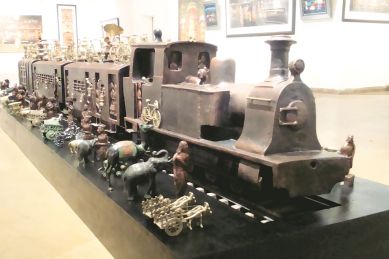📣 For more lifestyle news, click here to join our WhatsApp Channel and also follow us on Instagram
Narratives from Nepal
A year after the devastating earthquake hit Nepal, Kathmandu-based Uma Shankar Shah brings an exhibition of paintings on steam engines, Bollywood posters and Hindu deities

Most of Nepali artist Uma Shankar Shah’s canvases at Visual Arts Gallery, India Habitat Centre, Delhi, are marked by images of trains and posters of popular Bollywood films of yesteryear. His painting, Mahabir has Pakeezah, Mughal-e-Azam and Mother India hoardings standing tall while a train stops at a platform with newly-wedded couples as passengers. The grooms are dressed as Ram, according to tradition in Nepal.
Shah, 51, has been attracted to steam engines since he was in Class IX. He would go to the station everyday to watch trains pass by. “My happiness had no limit whenever I got the opportunity to touch trains. Hindi films were first promoted at railway platforms through handmade posters. I was fascinated by the posters of Nargis, Manoj Kumar and Madhubala,” says the artist, who is based in Kathmandu.
His first solo in the Capital, titled “Roti-Beti”, comprising 33 paintings, etchings and an on-site installation, uses elements common to India and Nepal to bring out their shared history. The images are derived from the artist’s childhood experiences. “The trains gave people their livelihood (roti) as they began to transport timber, wheat and jute for the British. Secondly, many Indian women migrated to Nepal after marriage (beti). Hence, the title,” says the artist, who is a professor of Fine Arts at Tribhuvan University.
In Sita-Ram, there are posters of Bajirao Mastani and 1942 Love Story, multiple figures of Bani Thani, considered India’s Mona Lisa, as well as Sita and Ram on a platform looking into each other’s eyes. The last serves as a metaphor for marriages between people from either sides of the border. “Sita was from Mithila in Nepal and Ram was from India,” says Shah. Incidentally, his artist wife Seema is from Varanasi. The painting reveals Shah’s fascination for Mithila and Rajasthani miniature art.
The artist is also exhibiting an 18-ft train installation — with the roof and compartments, platform and human figures moulded from fibre and metal — to bring alive the rail experience for viewers. The roof is loaded with utensils, cycles, lanterns and gramophones that travellers usually carried with them.
In Cityscapes, Shah remembers the Nepal earthquake by painting a landscape full of temples. He had landed at Delhi airport, when the earthquake struck Nepal. “I had been working on trains since 2014 but when the quake happened, I was so affected by it that I decided to portray it. I wanted to show the temples and their beauty in full glory before many of them were destroyed,” he says.
📣 For more lifestyle news, click here to join our WhatsApp Channel and also follow us on Instagram